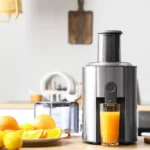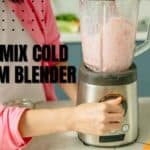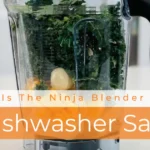Both blenders and juicers are everyday kitchen gadgets that make wholesome and energizing drinks. Despite having similar goals, the two are different from one another. In contrast to juicers, which are made expressly to extract juice from fruits and vegetables, blenders are primarily made for blending and pureeing foods. This raises a typical query: Can a blender function as a juicer?
In this post, we’ll examine how blenders and juicers work, how they vary, and if a blender can efficiently extract juice instead of a juicer. We’ll go into the workings of both devices, go through the advantages and disadvantages of utilizing a blender as a juicer, and provide some advice on how to get blender-juicing-like outcomes.
Difference Between Blender and Juicer

Before heading to the main topics, let’s see how a blender is different from a juicer:
- The final product produced by a juicer and a blender differs significantly. While a juicer separates the juice from the fiber and pulp, a blender keeps all of the ingredients—including the fiber and pulp—intact.
- Whole fruits and vegetables may be processed in blenders and a wide range of other components. Blender juice recipes can be more versatile since they manage soft and complex parts. On the other hand, juicers are created exclusively to extract juice from fruits and vegetables.
- Compared to juicers, blenders produce thicker and more full drinks due to their capacity to retain fiber and pulp. Smoothies delivered in blenders often include all components, making them more nutrient-dense.
- Juices produced by juicers are clear and devoid of pulp and fiber. They are, therefore, perfect for people who like lighter drinks or who wish to drink a lot of juice without getting full.
- Juicers and blenders differ from one another in terms of how they are cleaned. Blenders are typically simpler to clean because there are fewer components to disassemble. Juicers frequently have additional parts that need to be disassembled and carefully cleaned.
Similarities Between Blender and Juicer
Here are some of the similarities between Blender and Juicer:
- Both a blender and a juicer are kitchen tools for preparing meals.
- Both feature a base that is motorized and supplies electricity to the device.
- The ingredients are placed in a container or jar attached to both pieces of equipment.
- Both contain cutting edges or other devices for blending or juicing the contents.
- To regulate the blending or juicing process, the Blender and the Juicer offer various speed options.
- Both of them need the power to function.
- To prevent accidents, both appliances incorporate safety measures such as locking mechanisms.
- Both of them may be used to make a variety of dishes and drinks.
- The Blender and the Juicer are available in various sizes and styles to accommodate different demands and tastes.
Can Blender work as a Juicer?
Yes, a blender may serve as a juicer to a certain extent. Remembering that juicers and blenders are two distinct kitchen machines with unique functions is crucial. Both can process fruits and vegetables, but they do so in different ways and provide specific outcomes.
Ingredients are mostly blended and pureed in blenders. It produces a smooth consistency by chopping and combining the components using sharp blades. The entire fruit or vegetable and the pulp and fiber are combined while making juice in a blender. As a result, the drink is thicker and more textured than juice from a juicer.
However, a juicer separates the pulp and fiber from fruits and vegetables while extracting the juice. Centrifugal and masticating juicers are the two primary categories of juicers. Masticating juicers employ a slower crushing and squeezing motion, whereas centrifugal juicers use fast-spinning blades to extract the juice from the pulp. You can easily use them to make apple, Carrot, and Ginger Juice using a Blender.
By juicing fruits and vegetables into a liquid, a blender may approximate specific characteristics of a juicer, but it cannot fully imitate the extraction procedure of a specialized juicer. Blenders frequently leave more pulp and fiber, which gives the finished product a thicker consistency. Additionally, some products, such as leafy greens, may not yield as much juice when juiced in blenders.
How to Use a Blender as a Juicer?
If you don’t have a specialist juicer on hand, using a blender as a juicer might be a practical option. While blending and pureeing are the primary purposes of blenders, juice from fruits and vegetables can still be extracted using a blender.
The following steps will show you how to utilize a blender as a juicer or how to make juice in a blender:
- Choose the fruits or vegetables you wish to juice first. To get rid of any dirt or pesticides, wash them well. To make them simpler to combine, peel them into small pieces.
- In contrast to juicers, blenders need some liquid to aid in the blending process. Depending on how many components there are, add a tiny amount of water to the Blender—generally between 1/4 and 1/2 cup.
- In the blender jar, add the chopped fruits or vegetables. Lock the lid firmly in place and mix at a moderate speed before gradually raising it to a high pace. Blend until a smooth consistency is reached.
- Once combined, pour the mixture onto a cheesecloth or fine-mesh strainer set over a basin or jug. With a spoon or spatula, gently push down the pulp to release as much juice as possible, leaving the fibrous pulp remaining.
- You will find the juice extracted after straining in the basin or jug beneath the sieve. Pour this liquid carefully into a different container, discarding any sediment that may have passed through.
- Repeat the filtering procedure to get more juice out if there is still a lot of pulp in the strained liquid. Alternatively, re-blender the pulp with extra water and strain it again.
- Juice can be served immediately once you’ve acquired the desired quantity. You may sip it or add ice cubes for a refreshing beverage.
What Type of Blender Should I Use?
It’s crucial to consider your unique requirements and tastes when selecting a blender. There are many different types of blenders on the market, each with a particular function. A countertop blender with a strong motor and sharp blades is perfect for everyday blending chores like creating smoothies, pureeing soups, or smashing ice. These blenders frequently offer many speed options and can process various foods.
A portable personal blender with a small footprint and a detachable travel cup would be more appropriate if you’re searching for a blender designed for blending single-serve smoothies or protein shakes on the move. These blenders are practical and straightforward, with features like pulse blending and dishwasher-safe parts.
A powerful blender with tough blades is advised for more specialized activities like milling grains, grinding spices, or producing nut butter. These blenders are made to handle more challenging substances and deliver reliable results. Moreover, you can quickly try blender juice recipes for weight loss with any blender you choose.
Ultimately, the kind of Blender you choose will depend on your needs, finances, and tastes.
The Dos and Don’ts of Making Juice With a Blender
Using a blender is sometimes not an easy task, especially for beginners. Therefore, this section guides you through some steps you need to take care of while using your Blender. Plus, by following these instructions, you can quickly learn how to make juice step by step like a pro.
Dos
- For juicing, pick ripe, fresh fruits and vegetables. Fresh vegetables have superior nutritional value and flavor.
- Before juicing, wash your produce well to eliminate any dirt, pesticides, or pathogens.
- To guarantee a smooth mix in the Blender, chop your fruits and veggies into smaller pieces.
- Add a bit of liquid to the mixture to blend and produce the correct consistency, such as water or juice.
- Start at a moderate speed to prevent splattering or overflow, and gradually raise it.
- Try different fruit and vegetable combinations to produce distinctive flavors and maximize nutritious value.
- To enjoy your newly prepared juice and avoid oxidation, eat it immediately.
Don’ts
- Avoid adding too many components at once to the Blender. The motor may be strained, and the blending process may be hampered.
- Hard or fibrous parts, such as seeds, pits, or rough stems, should not be blended since they can harm the Blender’s blades.
- Avoid over-blending the juice since it might heat up and lose some of its nutritious worth.
- Remember to carefully clean your Blender after each use to prevent residue accumulation and to preserve cleanliness.
- Juice stored for a long time might lose its nutritional content and freshness.
FAQs
What’s The Difference Between Juice and Smoothies?
Juice and smoothie are different. Smoothies are blended drinks that contain whole fruit or vegetable, including fiber, instead of juice, the liquid extracted from fruits or vegetables.
Are Smoothies or Juice Better for You?
Because smoothies retain the fiber from fruits and vegetables, which helps control blood sugar levels and encourages satiety, they are typically healthier than juice. However, the ingredients used and each person’s dietary requirements affect the nutritional value of smoothies and juice.
Can You Make Fresh Juices With a Blender?
Yes, you may prepare fresh juices in a blender by adding water to fruits or vegetables and mixing them. Then, drain the liquid to get rid of any pulp. Although generally speaking, a juicer is more effective in extracting juice from vegetables.
Why Would You Use a Blender to Make Juice?
Juice preparation with a blender is advantageous since it preserves the fiber content of fruits and vegetables, makes the process quicker and more straightforward, and allows you to mix different juices.
Is a juicer the same as a blender?
No, a blender and a juicer are not interchangeable. A juicer is utilized when juicing fruits and vegetables; when blending and mixing materials, a blender is employed.
Final Thought
In conclusion, while using a blender instead of a juicer is feasible, the results will differ noticeably. Juicers are made to extract juice solely; blenders are better suited for smoothies containing whole fruit or vegetables. Ultimately, whether to use a blender or a juicer relies on personal preference and the finished product’s desired consistency.






